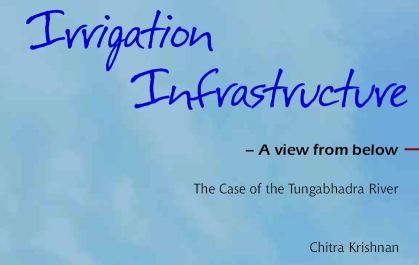Research Papers
New knowledge resources: Nitrates & cancer
Posted on 19 Apr, 2009 02:02 PM  Nitrate/Nitrite contamination is a potentially serious problem for India today, after flouride and arsenic. This contamination occurs largely through the mixing of fertiliser run-off and sewage with water meant for human use. New research reveals that Nitrate/Nitrite contamination can cause severe human health problems including cancer. Below are two research papers from the Environment Health Perspectives (EHP) Journal, written in the context of the United States, that give an idea of Nitrate/Nitrite contamination and their impact on human health. Workgroup Report in the November 2005 issue: "Drinking Water Nitrate and Health - Recent Findings and Research Needs". Read the paper here: https://www.indiawaterportal.org/tt/dwm/res/Drinking_Water_Nitrate_and_Health_Nov%202005_EHP.pdf "A Review of Nitrates in Drinking Water: Maternal Exposure and Adverse Contents Reproductive and Developmental Outcomes", appeared in the March 2006 issue. Read the paper here: https://www.indiawaterportal.org/tt/dwm/res/A_Review_of_Nitrates_in_Drinking_Water_Mar_2006_EHP.pdf
Nitrate/Nitrite contamination is a potentially serious problem for India today, after flouride and arsenic. This contamination occurs largely through the mixing of fertiliser run-off and sewage with water meant for human use. New research reveals that Nitrate/Nitrite contamination can cause severe human health problems including cancer. Below are two research papers from the Environment Health Perspectives (EHP) Journal, written in the context of the United States, that give an idea of Nitrate/Nitrite contamination and their impact on human health. Workgroup Report in the November 2005 issue: "Drinking Water Nitrate and Health - Recent Findings and Research Needs". Read the paper here: https://www.indiawaterportal.org/tt/dwm/res/Drinking_Water_Nitrate_and_Health_Nov%202005_EHP.pdf "A Review of Nitrates in Drinking Water: Maternal Exposure and Adverse Contents Reproductive and Developmental Outcomes", appeared in the March 2006 issue. Read the paper here: https://www.indiawaterportal.org/tt/dwm/res/A_Review_of_Nitrates_in_Drinking_Water_Mar_2006_EHP.pdf
Ph.D in Ecological Sanitation by a student at the University of Agricultural Sciences, Bangalore
Posted on 16 Apr, 2009 11:21 AMContacts needed for water sanitation project in Krishnanagar, West Bengal
Posted on 14 Apr, 2009 11:31 AMMy name is Deb Gangoapdhyay and I am a student at Yale University. I and a fellow student, Yuzhe Feng, have received funding to conduct a water quality and sanitation project in the Krisnanagar district of Nadia, West Bengal.
Hydroelectric power projects & climate change: A case study of Ravi basin in Himachal Pradesh
Posted on 09 Apr, 2009 11:34 AMThe following is a paper by Dr. Mohinder Slariya based on data collected during his Ph.D work. The work contains data sourced from the India Water Portal, and aims to illustrate local area climate changes with the development of hydroelectric projects. The abstract of the paper has been quoted below, with the full paper available as a download!
Abstract
Dams have had serious impacts on the lives, livelihoods, cultures and spiritual existence of indigenous, tribal and illiterate people, moreover on the physical environmental conditions and on the biodiversity of the area concerned. The dam related developmental activities in Ravi catchment area have been threatening the biodiversity in the whole catchment. There are more than 50 rivulets in the Ravi catchment and on which more than 70 power projects have been planned by the government by putting biodiversity at the stake. Developmental activities have unintentionally produce weather and climate modifications on a larger scale and threaten the existing biodiversity. Such developmental activities have been started day back in 1980s in Ravi basin with the installation of Baira Suil Power Project and today it has covered all most all Ravi basin starting from interstate broader of Jammu & Kashmir, Punjab and Himachal Pradesh and engulfed the green cover of the area. Because of this extinction the catchments area is experiencing drastic climatic changes, because of 100 km reservoirs of Shahpur Kandi (125MW), Thein Dam (600MW), Chamera-I (540MW) and Chamera-II (300 MW) and tunnelization of Ravi in 19.38 kms with a dia of 7 to 9 meters and 102 meters high surge shafts with 15.5 meters dia and underground power houses of Chamera-I & II and dry Ravi in almost all its natural route (27 kilometers in Chamera I & II). In this dry region there is a tremendous increase in the temperature and there is no timely and usual rain in the basin after the installation of power projects.
"Irrigation infrastructure - A view from below"
Posted on 27 Dec, 2008 03:52 AM "Irrigation Infrastructure - A View from below" is a new research study by Chitra Krishnan funded by the "Knowledge in Civil Society" initiative.
"Irrigation Infrastructure - A View from below" is a new research study by Chitra Krishnan funded by the "Knowledge in Civil Society" initiative.
Half full, half empty: The Bundelkhand water crisis
Posted on 31 Oct, 2008 10:49 AMWater and Sanitation Perspective series from Water Aid India, disseminates issues and experiences in India's water and sanitation sector. It is an outcome of WaterAid India's programme and policy work. It analyses the root causes for such a scarcity of water during the five year drought in Bundelkhand.
Quick and easy: SODIS and Nimbu Pani for potable water
Posted on 26 Sep, 2008 05:57 AMHere is a slightly long and complex paper but the sum and substance of it seems to be that Solar Disinfection (SODIS) combined with Nimbu pani is excellent to reduce e-coli count and inactivate it substantially. Nimbu paani also serves as an indicator that the water has been SODISED.
Groundwater recharge from parking lots by Prof. Prithvi Singh Kandhal
Posted on 12 Sep, 2007 01:21 AMAttached is an interesting document from Prof. Prithvi Kandhal about using porous asphalt in parking lots so that rainwater seeps through it and recharges groundwater.
Dr. Kandhal has published many papers and has significant credentials in his areas of expertise. He resides in Jaipur after 35 years of working in the US.